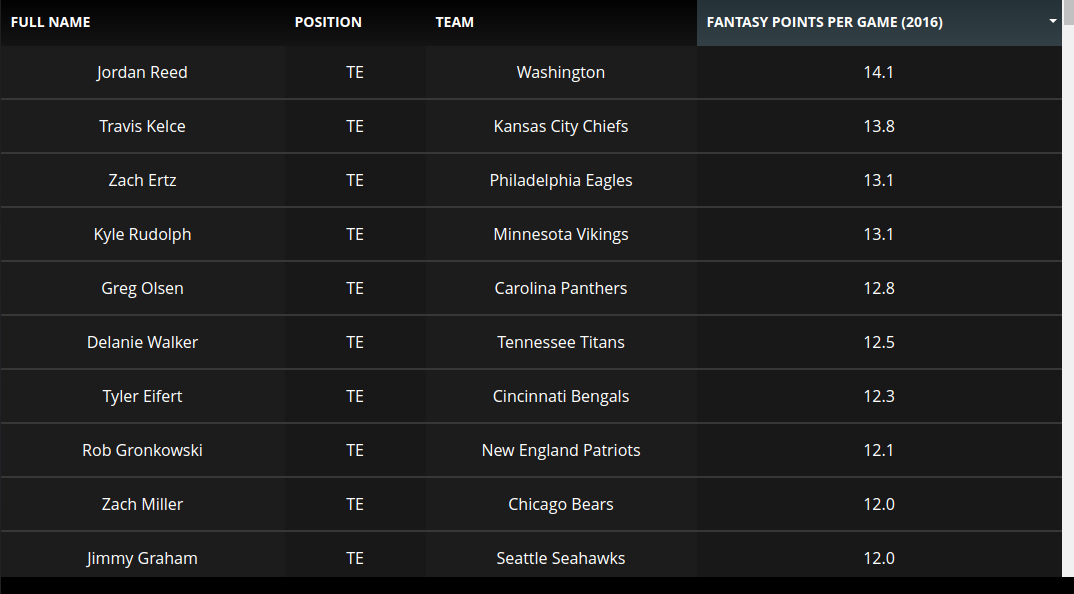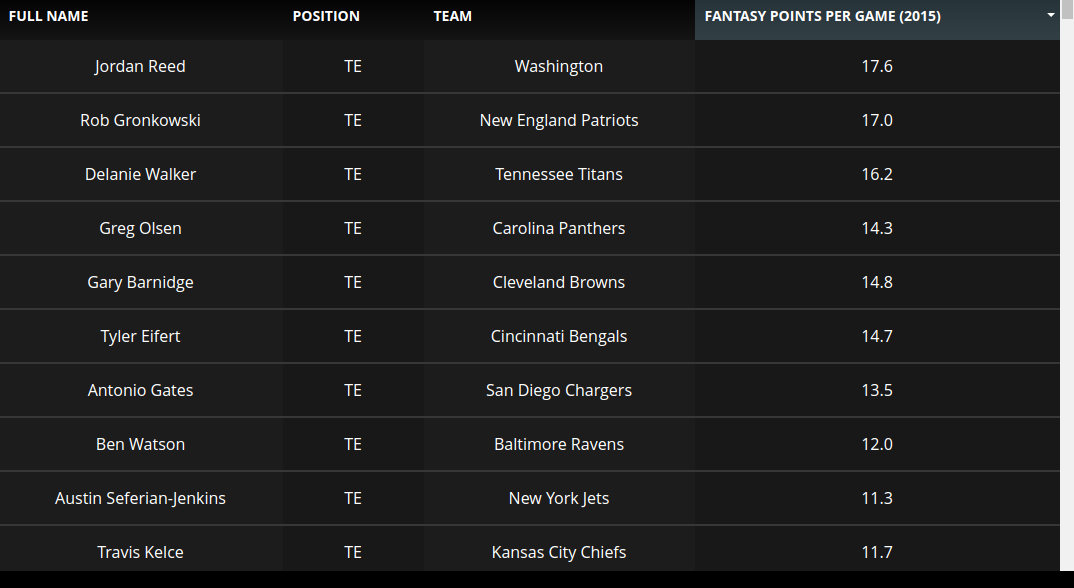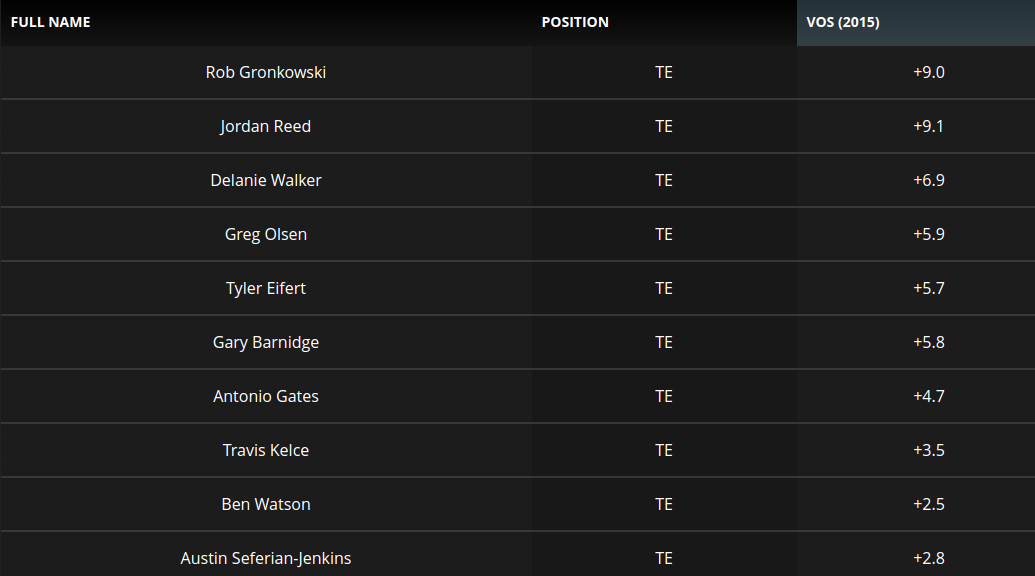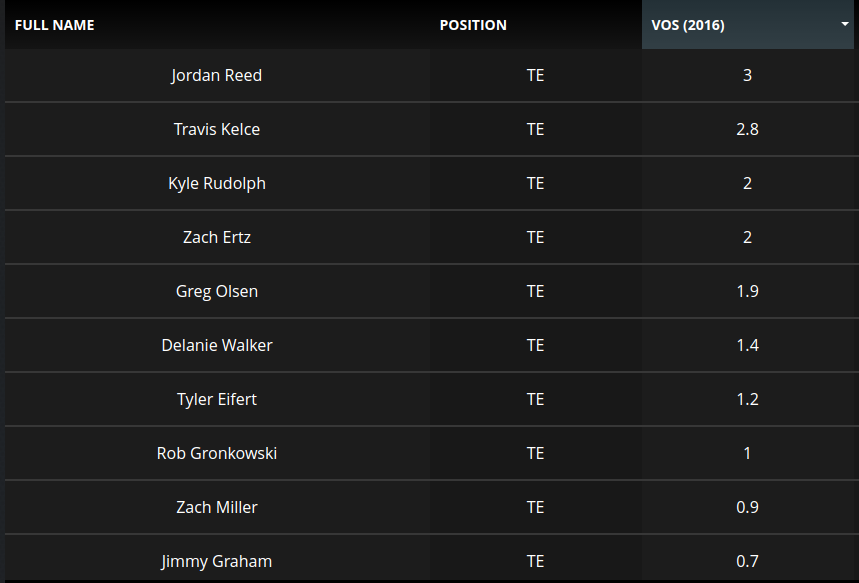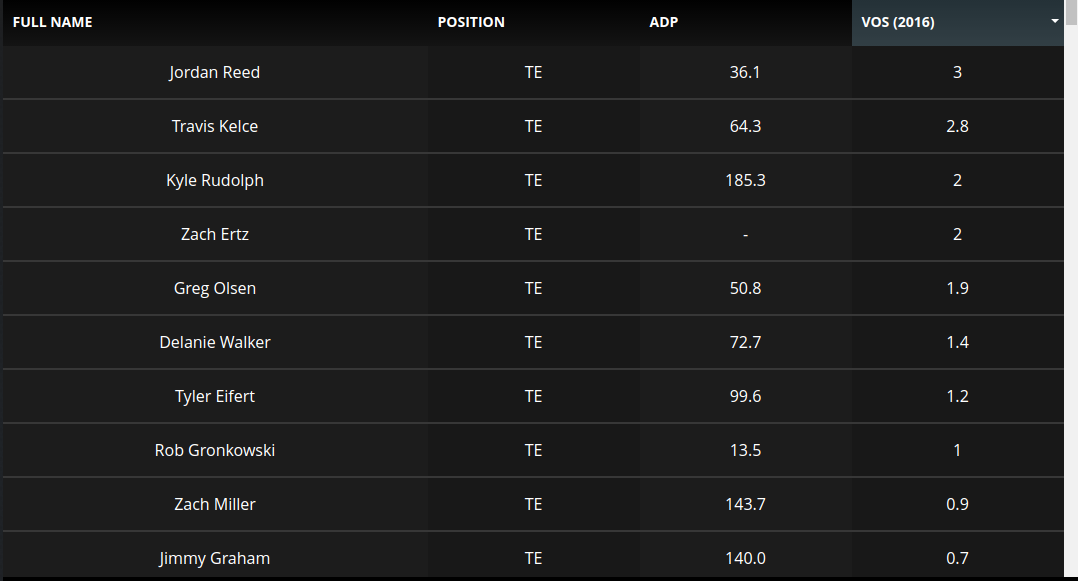You played fantasy football last season, drafted all your players, had a couple of solid wide receiver performances, always knew who your quarterback was going to be, and maybe even saw a few running backs in your Zero RB lineup pay off.
Then, like everybody else, you didn’t have the slightest clue with what to do at tight end. Most likely because nearly all of them were posting scores below their projections, and even your streaming options weren’t paying off.
Not to worry, you weren’t alone. The tight end play for fantasy owners in 2016 felt well-below standard compared to recent seasons, and now it’s time to dissect why, and figure out what we should expect in 2017.
PlayerProfiler.com offers what I consider to be one of the most valuable stats when evaluating players for your fantasy team. Granted, hind sight is always 20/20, but you could almost make the case that you could have gone Zero TE in last year’s drafts, and ended up seeing just as much production from your plug-and-play options, as the guy who started Jordan Reed every week did.
That valuable stat is value over stream, which calculates a player’s fantasy points per game over the average waiver wire replacements in standard fantasy league formats during either the current season (or previous year during the offseason) and adjusts for positional bust rates.
To completely understand how value over stream works for individual players, checkout the article that introduced it all back in 2015.
The Bare Facts
One of the most significant drops in value over stream (VOS) that took place league wide from 2015 to 2016 was that of the tight end position, which shouldn’t come as a surprise to fantasy owners.
The first player to be considered as the “Stream TE” is the tight end who ranks 19th in the league in fantasy points per game. In 2016, those players were Julius Thomas, Charles Clay and Ladarius Green, who all averaged 9.1 fantasy points per game, which is only a five point differential from Jordan Reed‘s 14.1 fantasy points per game, which led all tight ends in 2016.
Compare that to 2015, where the 19th ranked tight end in fantasy points per game was Charles Clay (9.4), while Jordan Reed again led the way with 17.6 fantasy points per game.
Enter your value over stream champion for 2015 and 2016, Jordan Reed, who has led all tight ends in VOS over the last two seasons (+9.1 in 2015) (+3.0 in 2016), and you now give way to the significant drop we witnessed this past season with tight ends over the last year.
But is what appears to be a huge drop off as drastic as it initially appears? The fact that Jordan Reed was only better than a guy like Eric Ebron who posted a 0.0 VOS in 2016 by a few yards or receptions per game. It almost doesn’t seem possible, but that was the reality of last season.
The VOS of Yesteryear
For starters, the average VOS among the top 10 tight ends for 2015 comes in at only a +5.3 VOS, with Jordan Reed‘s 9.1 VOS (No. 1) and Rob Gronkowski‘s +9.0 VOS (No. 2) being the outliers in this equation. The third highest VOS in 2015 belonged to Delanie Walker (+6.9 VOS).
We saw a similar trend in 2014, where the average VOS for top 10 fantasy tight ends was only +4.6, with Rob Gronkowski leading the way with a +9.2 VOS. The second-highest VOS for tight ends that season was the +6.1 VOS posted by Jimmy Graham, who was worth only 1.5 more fantasy points per game than the stream tight end.
The average VOS of +1.7 in 2016 among tight ends was no doubt disastrous, but in all actuality, the apparent monumental drop equates to nothing more than a handful of receptions or yards per game compared to that 19th-best stream tight end you can essentially acquire any week of the season.
The Fantasy Points Per Game Problem
In 2016, there were 10 tight ends who averaged 12.0-plus fantasy points per game, compared to the eight who averaged 12.0-plus fantasy points per game in 2015.
While the number of tight ends who averaged 12.0 or more fantasy points per game only differentiates by two players, Jordan Reed‘s +3.0 VOS for 2016 compared to his +9.1 VOS in 2015 is mostly due to the fact that there were two more players posting scores closer to his 14.1 fantasy points per game last season.
Compare that to the fact that there were two less players with 12.0-plus fantasy points per game in 2015 chasing Jordan Reed‘s absurd 17.4 FPPG, and you begin to see just how elite he was over the last two seasons, and even how elite Rob Gronkowski was in 2014 (17.0 fantasy points per game) and 2015 (17.8 fantasy points per game).
NOTE: Only four tight ends averaged 12.0 or more fantasy points per game in 2014.
If you’re keeping score at home, we have seen a climb in fantasy points per game among tight ends over the last three seasons, with four players averaging over 12.0 or more fantasy points per game in 2014, eight averaging that total in 2015 and 10 tight ends averaging 12.0-plus in 2016.
Even the number of tight ends who averaged 10.0-plus fantasy points per game has risen over the last three seasons, with 10 tight ends eclipsing the mark in 2014, 16 eclipsing it in 2015 and 17 tight ends averaging 10.0 points per game or more in 2016.
The New Reality and 2017 Solution
The recent rise in fantasy points per game among tight ends shows the continuing evolution of the tight end position in the NFL.
To be clear, Jordan Reed hasn’t gotten worse, but guys like him and Rob Gronkowski are becoming more expendable in fantasy drafts as other teams begin to utilize the position in the passing game with greater frequency, as evidenced by the increase in fantasy points per game.
No fantasy owner (at least those who frequently visit PlayerProfiler.com) should ever feel a need to draft a tight end in the early rounds, but the recent change in VOS further solidifies why it’s acceptable to hold off on the position in your fantasy drafts.
While VOS leader Jordan Reed had an average draft position (ADP) of 36.1 in 2016, the tight ends who finished second and third in VOS, Travis Kelce with a +2.8 VOS (No. 2) and Kyle Rudolph with a +2.0 VOS (No. 3) were taken far later in drafts. Travis Kelce‘s 2016 ADP was 64.3 and Kyle Rudolph‘s ADP was 185.3.
For a position that often features far less explosive players, less targets and less yards on a yearly basis, it’s not surprising to see other tight ends gaining on once distinguished players of the same position. While there are still tight ends in the league who are undoubtedly viewed as more elite players than their counterparts, recent VOS suggests that your chances of landing a player of similar caliber late in a draft are increasing. Additionally, keep in mind that VOS is a stat that measures value over streaming compared to all offensive positions in fantasy football. It is not ranked solely on position in the grand scheme of things.
While Jordan Reed did rank first among tight ends in VOS in 2015 and 2016, when compared to all other position players, he topped out at 54th-overall in 2016 VOS. Save those valuable early picks for players with elite VOS in your 2017 drafts, and don’t be discouraged by the marginal difference among tight end VOS from 2016. The elite tight ends aren’t falling off a cliff, there are just more striving to reach the peak, resulting in a position that is very capable of streaming heading into next season.

